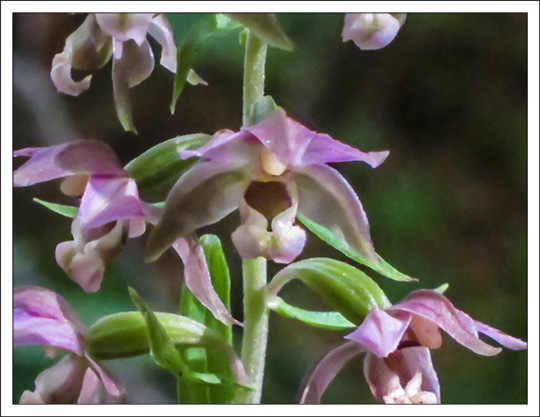Adirondack Wildflowers:
Helleborine Orchid (Epipactis helleborine)
 Adirondack Wildflowers: Helleborine Orchid (Epipactis helleborine) on the Heron Marsh Trail ((25 July 2012)
Adirondack Wildflowers: Helleborine Orchid (Epipactis helleborine) on the Heron Marsh Trail ((25 July 2012)
| This page is no longer being updated. For an updated and expanded version of this material, see: Helleborine (Epipactis helleborine). |
Helleborine Orchid (Epipactis helleborine) is a non-native plant which produces small purplish green flowers in the summer. Its small greenish-purple flowers are arranged in a spike-like cluster of many stalked flowers. The flower is 3.4 to one inch wide. The lower petal forms a bowl, with a greenish-purple lip. The petal color is rather variable, ranging from pale yellow green to pink to deep reddish purple, usually with darker purple veins. The leaves are oval to lance-link and alternate; they clasp the stem. The veins in the leaves are parallel. The leaves are variable in size, with the leaves becoming smaller as they ascend the stem. The stem is light green and covered with short hairs. The plant is one to three feet in height.
Helleborine Orchid is a member of the Orchidaceae (Orchid) family. It is also known as Hellebore, Helleborine, Eastern Helleborine, Broad-leaved Helleborine, and Broad-leaved Orchid.
Helleborine Orchid, the only alien orchid found in New York State, is not native to the Adirondacks or to North America. It is an escaped orchid of Eurasian origin. This plant was first reported near Syracuse, New York, in 1879. It has since spread throughout much of the northeast, as well as north to southern Ontario, west to Minnesota and south through Pennsylvania. It has become the most common woodland orchid in its range. Helleborine Orchid is not considered to pose an environmental problem in most areas and is not included in most invasive plant lists for the US, New York State, or the Adirondack Mountains. However, it is viewed as an invasive species in Wisconsin, where it has become a serious problem in Door County.
 Adirondack Wildflowers: Helleborine Orchid (Epipactis helleborine) on the Heron Marsh Trail ((25 July 2012)
Adirondack Wildflowers: Helleborine Orchid (Epipactis helleborine) on the Heron Marsh Trail ((25 July 2012)
Helleborine Orchids grow in all types of woods, along roadsides, and around trees in most types of soil in the Adirondack Mountains and upstate New York. The plant can be found throughout the Northeastern United States, south to Tennessee. It can also be found along the western seaboard, including California and British Columbia.
At the Paul Smiths VIC, Helleborine Orchid may be seen along the many of the trails, including the Heron Marsh Trail, Barnum Brook Trail, Logger's Loop Trail, Boreal Life Trail, Woods and Waters Trail, and Bobcat Trail. It usually blooms in this part of the Adirondack Park from late July to late August, depending on the weather.
References
- United States Department of Agriculture. Plants Database.
- NatureServe Explorer. Online Encyclopedia of Life.
- University of Wisconsin. Robert W. Freckmann Herbarium.
- Connecticut Wildflowers. Wildflower Guide.
- Minnesota Wildflowers. Database.
- New York Flora Association. New York Flora Atlas.
- Lawrence Newcomb. Newcomb's Wildflower Guide (Little Brown and Company, 1977), pp.48-49.
- Roger Tory Peterson and Margaret McKenny. A Field Guide to Wildflowers. Northeastern and North-central North America (Houghton Mifflin Company, 1968) pp. 371-373.
- William K. Chapman, et al. Wildflowers of New York in Color (Syracuse University Press, 1998), pp. 114-115.
- Steven Clemants and Carol Gracie. Wildflowers in the Field and Forest: A Field Guide to the Northeastern United States (Oxford University Press, 2006), pp.132-133.
Information on Non-native Plants
- United States Department of Agriculture. List of Federal Noxious Weeds.
- United States Department of Agriculture. Composite List of Federal and State Noxious Weeds.
- Invasive Plant Atlas of the United States.
- National Invasive Species Information Center. Species Profiles.
- New York Invasive Species Clearinghouse. Invasiveness Assessment Scores and Ranks for 183 Nonnative Plant Species in NYS.
- The New York Botanical Garden. Catalog of Invasive Plant Species of the United States.
- Cornell University. Ecology and Management of Invasive Plants Program.
- Adirondack Park Invasive Plant Program. Terrestrial Invasive Plant Project.
